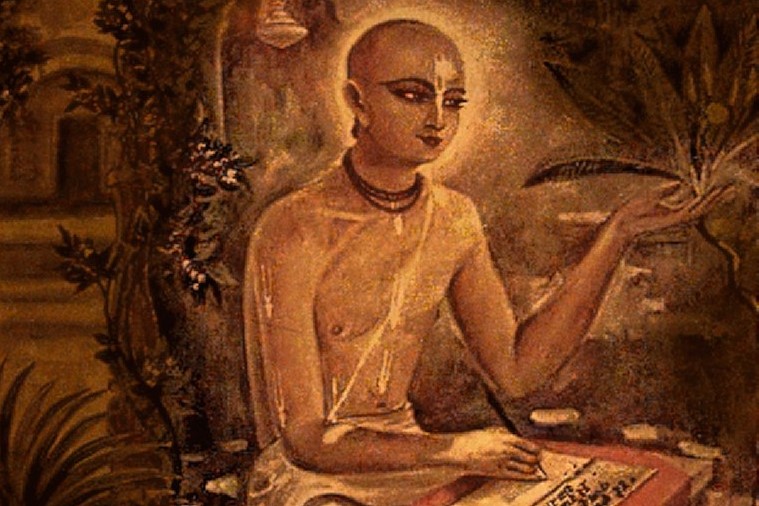Table of Contents
ToggleAbout
The son of Sri Vallabha and nephew of Sri Sanatana, Sri Rupa, all of whom were employed in the service of the Badshah Hussain Shah. Having been rewarded richly by the Badshah for their devices, their household life was very opulent.
Darsan of Sri Caitanya Mahaprabhu
When Sri Caitanya Mahaprabhu came to Ramakeli, Sri Jiva was blessed by having darsana of His worshipable lord, though he was just a baby at the time. Mahaprabhu indicated him to be a great future scholar in the Gaudiya sampradaya. Though he was only a child, Sri Jiva would meditate on Sri Caitanya constantly.
Early Life
REMEMBERING UNCLES AND FATHER
Later on, when his father and uncles renounced their family life in order to be with Mahaprabhu, the only child, Sri Jiva, was left with his mother in the family palace at Fateyabad. Jiva missed them greatly and whenever he would remember his father and uncles, or Sri Caitanya he would lose consciousness and fall to the ground.
SERVICE TO DEITIES
As he got a little older, Sri Jiva took up the worship of the Deities of Sri-Sri Rama-Krishna. He would carefully decorate Them and offer bhoga and arati, serving Them with his full attention. Even in his play, whatever games he played were connected with Sri Krishna’s pastimes.
EDUCATION
While studying under the local panditas he became proficient in grammar, poetry and rhetoric. His teachers noted his great intellect.
Met Sri Nityananda Prabhu
THE FIRST NAVADVIPA PARIKRAMA
Education in Kasi (Varanasi)
Went to Vrindavan
From here Sri Jiva set out for Sri Vrindavana where he received shelter at the lotus feet of his two uncles. Sri Rupa and Sanatana. Jiva stayed with Sri Rupa, who began to teach him Srimad-Bhagavatam. After initiating him with the divine mantra, Rupa engaged him in the service of Sri Sri Radha-Damodara.
Service of Srila Jiva Gosvami
Seeing that Jiva had quickly become conversant with the conclusion of Srimad-Bhagavatam, Sri Rupa engaged him in proof-reading his Bhakti-rasamrta-sindhu. At this time Sri Jiva compiled a commentary on Bhakti-rasamrta-sindhu called Durgama-sangamani. Sri Sanatana Gosvami compiled Sri Vaisnava-tosani, a commentary on the tenth canto of Srimad-Bhagavatam, which he gave to Sri Jiva for proof-reading. Under the order of Sri Sanatana, Sri Jiva compiled a commentary on that named Laghu Vaisnava-tosani. His writings, along with those of Sri Rupa and Sri Sanatana, Sri Gopal Bhatta, Sri Raghunatha Bhatta, Sri Raghunatha Dasa, Sri Krsna Dasa, Sri Kasisvar Pandita, and Sri Madhu Pandita, completely captivated the learned men of that time.
It was the beginning of a golden age at Vrindavana. Sri Jiva regularly brought water for Sri Rupa and Sanatana’s bath. He massaged their heads with oil, cleaned their asrama, worship the Deity, cooked and corrected manuscripts.
Debate in Agra
After the passing away of Sri Rupa and Sanatana, Sri Jiva continued the tradition that they had inaugurated. Once Sri Jiva travelled to Agra to debate with the Rajputs concerning the glories of Yamuna and Ganga rivers. He established that the Yamuna is more glorious than the Ganga as the Ganga emanates from Krishna’s lotus feet whereas the Yamuna is His own consort. At this the Moghul emperor was very much satisfied and wanted to present him something. Sri Jiva replied that he would accept some blank papers. So the emperor presented Jiva some stained paper. (At that time paper was very rare and most manuscripts were usually composed on leaves.) There is also a legend that once, when a moghul emperor (possibly Akbar) wanted to confer something on the Gosvamis of Vrindavana, they requested a farman (emperor’s order) that no living beings would be killed within Vraja. As a result of this no king would come to hunt there anymore.
His Siksa Disciples
The disciple of Lokanatha Gosvami, Narottama Dasa Thakura Mahasaya, Sri Gopala Bhatta Gosvami’s disciple Srinivasa Acarya Prabhu, and the disciple of Hrdaya Caitanya Prabhu, Sri Syamananda Prabhu, were greatly favoured by Srila Jiva Gosvami. Under his tutelage they studied all the literatures of the Gosvamis. Later he sent them to preach this knowledge in Bengal.
Literatures
Srila Jiva Gosvami composed many literatures, amongst them:
– Harinamamrta-vyakarana,
– Sutra-malika, Rasamrta-sesa,
– Gopala- virudavali, Sri-Madhava-mahotsava,
– Sri-Sankalpa-kalpavrksa,
– Brahma-Samhita-tika,
– Bhakti-rasamrta-sindhu-tika (Durgama-sangamani),
– Ujjvala-nilamani-tika (Locana-rocani),
– Gopala-campu,
– Sat-sandharbha (Tattva-sandarbha, Bhagavata-sandarbha, Paramatma sandarbha, Krsna-sandarbha, Bhakti-sandharbha, Priti-sandarbha)
– Srimad-Bhagavata-tika (Krama-sandarbha),
– Laghu-vaisnava-tosani (Tenth Canto Bhagavatam commentary),
– Sarva-sambadina (Commentary on Sat-sandarbha),
– Gopala-tapani-tika (Sri-Suhkha-bodhini),
– Padma-puranastha-yogasara-stotra-tika,
– Gayatri-vyakhya-vivrti (A commentary on the Gayatri mantra as described in the Agni Purana, chapters 216–7),
– Radha-Krsnarcana-candrika,
– Dhatu-sangraha,
– Bhavartha-sucaka-campu.
Srila Jiva Gosvami left ended his manifest pastimes in 1618 in Vrindavana.



One thought on “Sri Jiva Gosvami Brief Intro”
Sri Jiva Goswami ki Jay! 🙏
Comments are closed.